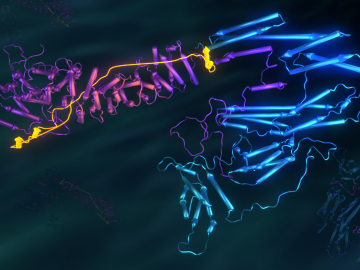
Filter News
Area of Research
- Advanced Manufacturing (11)
- Biology and Environment (5)
- Building Technologies (1)
- Computational Engineering (1)
- Computer Science (7)
- Electricity and Smart Grid (1)
- Energy Science (43)
- Fusion Energy (1)
- Materials (21)
- Materials for Computing (7)
- National Security (3)
- Neutron Science (23)
- Nuclear Science and Technology (2)
- Quantum information Science (3)
- Sensors and Controls (1)
- Supercomputing (10)
News Type
News Topics
- (-) 3-D Printing/Advanced Manufacturing (34)
- (-) Big Data (17)
- (-) Grid (22)
- (-) Machine Learning (14)
- (-) Microscopy (11)
- (-) Neutron Science (27)
- (-) Polymers (10)
- (-) Quantum Computing (5)
- (-) Quantum Science (12)
- Advanced Reactors (13)
- Artificial Intelligence (16)
- Bioenergy (17)
- Biology (21)
- Biomedical (11)
- Biotechnology (4)
- Buildings (21)
- Chemical Sciences (13)
- Clean Water (14)
- Composites (11)
- Computer Science (42)
- Coronavirus (11)
- Critical Materials (12)
- Cybersecurity (3)
- Emergency (1)
- Energy Storage (32)
- Environment (48)
- Exascale Computing (1)
- Fossil Energy (1)
- Frontier (1)
- Fusion (9)
- High-Performance Computing (12)
- Hydropower (6)
- Irradiation (2)
- Isotopes (5)
- ITER (3)
- Materials (36)
- Materials Science (34)
- Mathematics (3)
- Mercury (3)
- Molten Salt (5)
- Nanotechnology (12)
- National Security (3)
- Nuclear Energy (19)
- Partnerships (2)
- Physics (4)
- Security (1)
- Simulation (9)
- Space Exploration (10)
- Statistics (1)
- Summit (8)
- Transportation (36)
Media Contacts

Researchers at Oak Ridge National Laboratory demonstrated a 20-kilowatt bi-directional wireless charging system on a UPS plug-in hybrid electric delivery truck, advancing the technology to a larger class of vehicles and enabling a new energy storage method for fleet owners and their facilities.

Scientists at Oak Ridge National Laboratory used a focused beam of electrons to stitch platinum-silicon molecules into graphene, marking the first deliberate insertion of artificial molecules into a graphene host matrix.

Oak Ridge National Laboratory researchers working on neutron imaging capabilities for nuclear materials have developed a process for seeing the inside of uranium particles – without cutting them open.

Researchers at ORNL demonstrated that sodium-ion batteries can serve as a low-cost, high performance substitute for rechargeable lithium-ion batteries commonly used in robotics, power tools, and grid-scale energy storage.

A novel approach developed by scientists at ORNL can scan massive datasets of large-scale satellite images to more accurately map infrastructure – such as buildings and roads – in hours versus days.

To better determine the potential energy cost savings among connected homes, researchers at Oak Ridge National Laboratory developed a computer simulation to more accurately compare energy use on similar weather days.

Researchers at Oak Ridge National Laboratory demonstrated that an additively manufactured polymer layer, when applied to carbon fiber reinforced plastic, or CFRP, can serve as an effective protector against aircraft lightning strikes.

Researchers demonstrated that an additively manufactured hot stamping die can withstand up to 25,000 usage cycles, proving that this technique is a viable solution for production.

Researchers used neutron scattering at Oak Ridge National Laboratory’s Spallation Neutron Source and High Flux Isotope Reactor to better understand how certain cells in human tissue bond together.

In collaboration with the Department of Veterans Affairs, a team at Oak Ridge National Laboratory has expanded a VA-developed predictive computing model to identify veterans at risk of suicide and sped it up to run 300 times faster, a gain that could profoundly affect the VA’s ability to reach susceptible veterans quickly.


